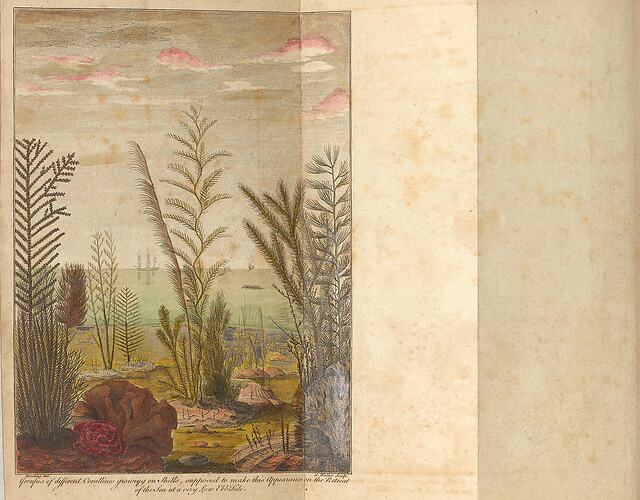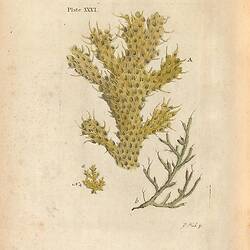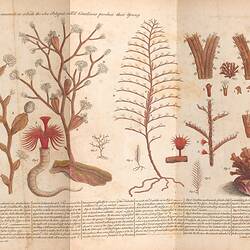Summary
Full title: An essay towards a natural history of the corallines, and other marine productions of the like kind : commonly found on the coasts of Great Britain and Ireland. To which is added the description of a large marine polype taken near the North Pole, by the whale-fishers, in the summer 1753.
London : Printed for the author; and sold by A. Millar, in the Strand; J. and J. Rivington, in St. Paul's Church-Yard; and R. and J. Dodsley, in Pall-Mall., M.DCC.LV. [1755]
This text is authored by Irish naturalist John Ellis (c.1710-1776), who lived and worked for most of his life in the London cloth trade. As a well-established linen merchant he was able to pursue an interest in natural history, and he became a fellow of the Royal Society of London in 1754. Ellis began collecting fossils, seaweeds and zoophytes (corallines) in the 1740s. His attempt to arrange the collection systematically led him to study the corallines in microscopic detail, through which he ascertained that they were animals. While not the first to suggest this, he was decisive in overturning the idea that corallines represented a link between plant and animal life. Ellis used an acquatic microscope designed by John Cuff, which is illustrated on one of the unnumbered plates. Cuff's miscroscope was designed with a moveable lens to facilitate the study of acquatic animals without disturbing them.
Ellis' 1755 work 'An essay towards a natural history of the corallines' contains descriptions and engravings of British zoophytes, including some species from America. Some of the engravings were based on original illustrations by German botanical artist Georg Dionysius Ehret. The plates were engraved by James Kirk, J. Mynde, H. Roberts and A. Walker.
Names of species (diagnostic phrases) are published in Latin, with translation of these names into English in the unpaged section with running title.
Physical Description
Forty-one plates (six folded), numbered Plate I-Pl. XXXVIII, Pl. 39; 28cm. Two plates (frontispiece, microscopical instruments) unnumbered. Plates 38-39 with explanations engraved on the plates, without letterpress text (missing in many copies). The plates are hand-coloured in an amateur hand, probably by a former owner rather than a professional. Plates and frontispiece are hand-coloured engravings, text includes woodcut printer's ornaments. Laid paper with watermark. Binding is half brown leather with gold tooling and raised bands. Marbled endpapers.
Significance
'An essay towards a natural history of the corallines' by John Ellis (1755) is the first comprehensive scientific study of marine invertebrates in Britain.
This copy shows evidence of former ownership by a number of scholars. The marginalia and hand-clouring suggest that the book has long been used as a working copy in the course of scientific study, with references to outside literature annotated throughout and an addenda copied into the back endpapers. It is not known who annotated the work, however the annotations appear to be in a 19th century hand, and were probably made by former owner Rev. Charles Wellbeloved.
Wellbeloved seems to have acquired the book while he lived in York, between 1792 and 1858. Wellbeloved was involved with a number of York's learned societies, and taught at Harris Manchester College, which was for a time based in his home.
'An essay towards a natural history of the corallines' was donated to Museums Victoria by former Honorary Associate Dr Jeanette (Jan) Watson, AM, whose involvement with the museum spanned 50 years. The volume is relevant to Museums Victoria due to our significant collection of hydrozoans, thought to be one of the most extensive reference collections in the southern hemisphere. While Ellis established the field of hydrozoan research, and is known as one of the first marine biologists in Western science, Museums Victoria has taken a leading role in their research in Australia since the 19th century. Local fieldwork was conducted by William Bale, Bracebridge Wilson and Baldwin Spencer, who were all affiliated with the museum, and who donated or described specimens in Museums Victoria's collections. Jan Watson furthered this area of scientific study over the course of her long career. Continuing the earlier pattern of use, this copy was used until recently for research by the donor.
The work is rare, with the English Short Title Catalogue (ESTC) listing 91 copies, and 7 holdings in Australian libraries. Museums Victoria Library also holds Ellis' later work 'The natural history of zoophytes' (1786).
More Information
-
Collection Names
-
Collecting Areas
-
Past Owner
Dr Jan E. Watson - Marine Science & Ecology Pty. Ltd., Geelong, Victoria, Australia
-
Past Owner
-
Past Owner
-
Author
-
Artist
-
Engraver
-
Engraver
-
Engraver
-
Engraver
-
Inscriptions
Front free endpaper verso has inscription in ink: "C. Wellbeloved / York" as well as various booksellers' marks in pencil. Front pastedown endpaper has inscription in ink: "Patricia M. Ralph / 1952". Back free endpapers have a [3] page 'Addenda' handwritten in pencil, in Latin and English, possibly in the hand of Rev. Charles Wellbeloved.
-
Category
-
Discipline
-
Object Dimensions
28 cm (Length), 20 cm (Width), 3 cm (Height)
-
References
Digitised version available online via BHL [Link 1] Clay, R 1932 'The history of the microscope : compiled from original instruments and documents, up to the introduction of the achromatic microscope', London, Griffin and Co. Leaney, E 2009 'John Ellis', Irish Dictionary of Biography, viewed 21/05/2022 DOI: [Link 2] Harrison, S 2010 'The Yorkshire Antiquarian Club 1849-c.1860', Bulletin of the History of Archaeology, vol. 20, no. 1, pp. 38-48. Stafleu & Cowan, p.1661 Nissen, C. Zoologische Buchillustration, p.1281 Engelmann, W. Bib. historico-naturalis, p. 576 English short title catalogue, T144774
-
Keywords
Cnidaria, Ctenophora, Bryozoa, Marine animals, Great Britain, Ireland







